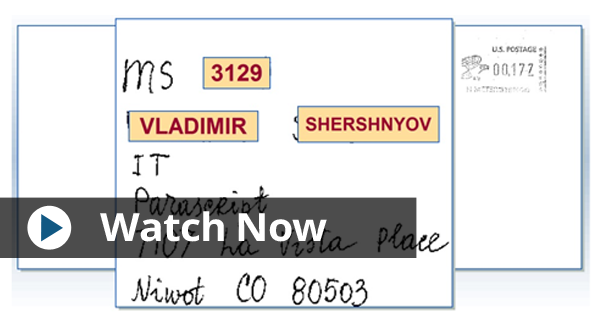State-of-the-art incoming mail processing software is able to locate the correct destination address block on the image of an envelope, flat-size mail piece, or parcel. The software automatically parses and recognizes the fields within this address block. It is designed to deal with different address block structures and automatically reads the variety of fields and formats that may be encountered on a mail piece. The fields may be located in different lines within the address block, may have different prefixes or have no prefix at all, and may be present within an address block or skipped.
The differentiator of this new approach is the ability to look beyond each particular field within the address block. New products in the market today are able to recognize fields combined in groups, find groups of fields that are stably present in the address block, set complex connections between fields within a group, define priorities that describe the importance of the field in determining a potential recipient of the mail, and, finally, build a chain that leads to the proper mail recipient.
Each company has a specific address structure. In small companies, for example, it may be limited to just the name of a recipient, followed by the company address. If a company structure is more complex, the internal address may include such fields as mail stop, department name, and post office box. But real life mail pieces often go beyond the typical address block structure. There are addresses that may include unusual fields, specific to a particular company (for example, drop code or division code). Big companies may have a hierarchical mail stop or department name structure (multiple nesting mail stops or departments) or a few mail stops, or department structures existing in parallel.
The advanced mechanisms used by incoming mail processing software allow for flexibility in describing and working with a variety of formats and cases. Ready-to-use blocks or predefined fields can provide a user-friendly definition of particular address structures in these systems. Predefined fields are those fields that are often encountered on mail pieces and imply standard information about field structure, field prefix or suffix, and expected field values. Such fields include first name, last name, prefix name, mail stop, department name, and others. The software contains knowledge about such fields enabling it to locate them on different mail pieces. It also offers mechanisms that allow for flexibility in modifying standard fields, so that they meet the requirements for a particular address format. In those situations when an address includes fields that cannot be defined using the predefined field types, the customer has an opportunity to define fields with unique characteristics. The technology does not have country-specific address structure constraints and can be readily applied to Latin-based addresses. It also opens new opportunities to implement this technology for a broader range of applications going beyond incoming mail processing and including clearing house mail sorting and the sorting of outgoing foreign mail.
An important part of the successful reading of handwritten and machine printed addresses belongs to contextual informationor utilizing a database describing company-specific address structure, fields specifying a destination, and a list of potential addressees. The database should contain the most comprehensive data, specifying valid fields and their values for a particular company. Fields on a mail piece are recognized and compared against records from the database to find a single record that matches the mail piece. There are also mechanisms that help resolve the ambiguities inherent to this task, which is difficult to formalize. For example, a mechanism that sets priorities helps resolve situations when a database has multiple records with several fields matching the same values. Alias mechanisms help to resolve the ambiguity caused by the fact that values of the same fields within the address may often be written differently. For example the first name William can be also written as Bill, Will, Willy, etc.; the department name Marketing may be spelled as Mktg or Market. Despite the various ways they may be written, all these words have the same meaning and, as such, describe the same destination specified in a database in a standard unique form.
The features mentioned here and other powerful mechanisms allow for the successful resolution of incoming addresses. The software can be easily integrated with various types of sorting equipment, and adapted to a companys business needs and requirements. Automated incoming mail processing brings significant benefits to organizations that implement it. The technology makes sure that incoming mail gets to the right place faster, reducing document processing time and raising the efficiency of business processes, while improving quality of customer service.
Click below to watch a quick video of incoming mail processing.




